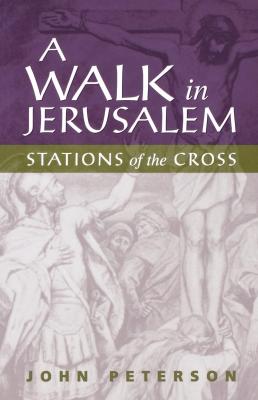ТОП просматриваемых книг сайта:
A Walk in Jerusalem. John Peterson
Читать онлайн.Название A Walk in Jerusalem
Год выпуска 0
isbn 9780819224941
Автор произведения John Peterson
Жанр Зарубежная эзотерическая и религиозная литература
Издательство Ingram
A
WALK in JERUSALEM
STATIONS of the CROSS
JOHN L. PETERSON
MOREHOUSE PUBLISHING
Copyright 1998 © by John L. Peterson
Morehouse Publishing, 4775 Linglestown Road, Harrisburg, PA 17112
Morehouse Publishing, 445 Fifth Avenue, New York, NY 10016
Morehouse Publishing is an imprint of Church Publishing Incorporated.
All rights reserved. No part of this book may be reproduced, stored in a retrieval system, or transmitted in any form or by any means, electronic, mechanical, including photocopying, recording, or otherwise, without the written permission of the publisher.
A Walk in Jerusalem: Stations of the Cross was produced at St. Gregory's College in Jerusalem.
The late Brother Gilbert Sinden, a Course Director at the College, wrote liturgies for the first through the thirteenth Stations of the Cross; however, he did not write the liturgy for the fourteenth station, but always used the “Confessions” and “Healings” that are included in this book every time he did the Stations of the Cross in Jerusalem. Every effort to discover the author of that material has proved fruitless so far, and the publisher would be grateful for any information about its provenance so that proper credit may be given.
Barbara Huston, former course member at St. George's College and riter for the College, was the original editor of the text; Margaret Dewey, former librarian of the College, provided key research on the Stations of the Cross.
Illustrations and map are courtesy of architect Donald Neraas, member of the College's North American Regional Committee.
Photographs are courtesy of Garo Nalbandian.
Cover design by Corey Kent.
Printed in the United States of America.
Library of Congress Cataloging-in-Publication Data Peterson, John L.
A walk in Jerusalem : stations of the Cross / John L. Peterson
p. cm.
ISBN 13 : 978-0-8192-1735-6
1. Stations of the Cross. 2. Christian pilgrims and pilgrimage—Jerusalem. 3. Jerusalem—Description and travel. I. Title
BX2040.P45 1998
232.96—dc21
97-44727
CIP
CONTENTS
III Jesus Falls for the First Time
V Simon of Cyrene Helps Jesus Carry the Cross
VIII Jesus Talks to the Weeping Women
X Jesus Is Stripped of His Garments
XIII Jesus’ Body Is Taken Down from the Cross
XIV Jesus’ Body Is Placed in the Tomb
Stations of the Cross
INTRODUCTION
NO ROAD IN THE HOLY LAND HAS BEEN MORE TRAVELED than the Way of the Cross in Jerusalem. It is an ecumenical phenomenon and never more so than today.
Franciscan monks in their brown robes lead groups along the route every Friday. Cruise-ship holiday groups in identical hats may be seen there any day of the week in tourist season. Pilgrims singing hymns in many languages are heard there. The Stations of the Cross is everyone's sacrament in the city where Christ actually was forced to his own crucifixion.
This book walks us through the Way of the Cross in Jerusalem with rites born in Jerusalem. We mark where Jesus Is Judged, Jesus Receives His Cross, Jesus Falls for the First Time, Jesus Meets His Mother, Simon of Cyrene Helps Jesus Carry the Cross, Veronica Wipes Jesus’ Brow, Jesus Falls a Second Time, Jesus Talks to the Weeping Women, Jesus Falls a Third Time, Jesus Is Stripped of His Garments, Jesus Is Crucified, Jesus Dies on the Cross, Jesus’ Body Is Taken Down from the Cross, and Jesus’ Body Is Placed in the Tomb.
We have made this walk for centuries one way and another, feeling it with our feet and living it in our hearts. We have thus transformed it into a folk sacrament, complete with its outward and visible sign of an inward and spiritual grace.
A twentieth-century Way of the Cross is mapped on the opposite page.
What is its history? The first record of this pilgrim practice, walking the Way of the Cross in Jerusalem after the death and resurrection of Christ, comes from the Spanish pilgrim Egeria. In 381 and 384 A.D. she made a Good Friday pilgrimage from the Mount of Olives to the Church of the Holy Sepulchre. This church, built over the site of Christ's crucifixion and burial, was already the Christian focal point in Jerusalem during Holy Week that it is today. On Good Friday, during Egeria's two visits, everyone spent three hours in the church hearing the Psalms and readings from the Epistles, the Acts, the Gospels, and other prophetic words connected with the Passion.
Such outdoor processions as Egeria's did not thrive in subsequent non-Christian rule in Jerusalem. Still, six liturgical stations on a processional route from the Mount of Olives to the Church of the Holy Sepulchre were described in tenth-century Holy Week records. The processional cross would then be carried within the church, from the Calvary site on the mezzanine floor to a small cave in the ancient stone quarry pit below, a cave known as the “holy prison.”
When the European Crusaders reached Jerusalem in the eleventh century, they found the Passion honored only as a Good Friday ceremony in a partially rebuilt Church of the Holy Sepulchre whose original had been destroyed in 1009. What had once been outdoor Stations of the Cross were now interior chapels honoring Christ's scourging, his crowning with thorns,

